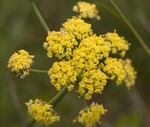For the better part of a century, scientists thought Bradshaw’s lomatium, a small yellow flower with dill-like leaves, was extinct. But now, after 31 years on the endangered species list, the U.S. Fish and Wildlife Service is ready to declare it a recovered species that no longer needs special protection.

The Bradshaw's lomatium, a member of the parsley and carrot family, may be de-listed by the USFWS. It's found in just a few locations in Oregon and Washington.
Peter Pearsall/USFWS
Getting the plant to this point took a lot of work.
“It’s a big accomplishment, and the progress that we’ve made is really dependent on partnerships with other groups, nonprofits and organizations,” said Tom Brumbelow, a government botanist. “This doesn’t mean the species doesn’t need management. It means we’re transitioning it back to other forms of management and conservation.”
In a press release Monday, Tierra Curry, a scientist at the Center for Biological Diversity, called the species’ recovery “another success for America’s most effective conservation law,” referring to the Endangered Species Act.
“We did an in-depth assessment to evaluate the viability of the species,” Brumbelow said. “We looked at the size, number, and distribution of the populations that are out here, and looked at the connectivity between them and the level of protection that land has.”
Bradshaw’s lomatium prefers to grow in wetland prairies, which used to cover much of the Willamette Valley’s floor. But the water was diverted for agriculture, dams were built to prevent seasonal flooding and much of the space was divided into plots of urban and agricultural land.
“The Willamette Valley happens to be a great place to grow ornamental plants, to grow grapes, it’s the agricultural breadbasket of Oregon,” said David Giblin the Herbarium Collections Manager at the University of Washington. As the agricultural industry grew, wetland prairie habitat decreased.
“Believe me, it’s a threatened habitat,” Giblin said, “There used to be a whole lot more of it.”
Today, its range is limited to a few areas in Puget Sound and Southwest Washington, and patches along the Willamette Valley.
The other threat to the plant was more subtle.
“Native Americans used fire management for a tool on these prairies, to manage game, manage vegetation and improve the growth of certain plants that were eaten or harvested for tools or basketry,” said Tom Kaye, the executive director of the Institute for Applied Ecology. The fires kept wooded plants from encroaching and helped keep seed-eating rodents out.
It was in this environment, constantly disturbed by fires and grazing, that Bradshaw’s lomatium evolved.
By the early 19th century, so little of the plant’s ecosystem was left, it was thought to be extinct. It wasn’t officially seen again until 1979, when a graduate student at the University of Oregon found a small population growing near Eugene. A handful of other groups were found. There were just 11 populations with roughly 25,000 flowers in 1988 when the plant was officially protected under the Endangered Species Act. The primary reason: threats to what little habitat was left.
It took a concerted effort from a large number of nonprofit groups, federal agencies and private landowners to bring Bradshaw’s lomatium back from the brink. And now, it’s met all the population benchmarks set for delisting the species.
That doesn’t mean the plant is entirely out of the metaphorical encroaching woods, Kaye cautioned. The ecosystem it needs to survive is just too rare. He estimates that less than 3% of the lomatium’s habitat remains. While he agrees that the plant has met all the qualifications necessary to delist, the overall ecosystem still faces threats.
“This is an exciting and significant milestone in species recovery and one we can celebrate,” said Kaye. “But moving forward, I’d like to see the species continue to be monitored and managed at protected sites, with fire and other tools to promote population growth. If the species becomes neglected again, it will slide back on a downward path.”
In a way, the species was always managed by humans. So now, it can’t survive without some human intervention.
“With just a couple of years without fire or grazing, you can see a catastrophic decline in the population,” Kaye said.
There's been a push across the Willamette Valley to restore more of the wetland prairies that once covered it — not just for Bradshaw's lomatium, but for a number of other species, as well.
The Fish and Wildlife Service says plants like the Willamette daisy, golden paintbrush and Kincaid's lupine live there, as do threatened birds like the streaked horned lark.
Even if Bradshaw’s lomatium is delisted, those areas will continue to be protected. And new conservation and habitat restoration efforts, in partnership with private landowners and nonprofits, will continue.
Correction: Nov. 27, 2019. An earlier version of this story misspelled the name of a government botanist. His name is spelled Tom Brumbelow.